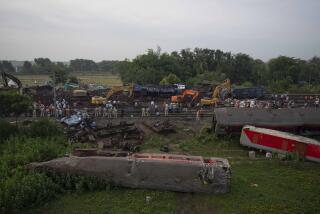Train Engineer Says He Lacked Key Information
- Share via
SAN BERNARDINO — The engineer controlling the Southern Pacific freight train that derailed, killing four people last week, told federal investigators Wednesday that he was unaware of an emergency maneuver that would have locked the train locomotive’s wheels as it careened down the steep Cajon Pass.
Frank Holland, who was released from the hospital Wednesday, told National Transportation Safety Board officials he did not believe it was possible to throw the train’s engines into reverse after he had applied emergency brakes part way down the grade.
NTSB investigators, however, have determined that such an action is possible and would have caused the wheels on the train’s six locomotives to lock up.
Whether taking such a step would have stopped the 69-car freight from becoming a runaway and leaping the tracks Friday remains unclear. But the new development raises questions about methods the railroad uses to instruct engineers before allowing them to pilot trains through the treacherous pass.
“Obviously, we’re looking into Southern Pacific’s methods of training to determine why engineer Holland did not know about this option,” NTSB spokesman Ted Lopatkiewicz said.
Another engineer, who has worked for Southern Pacific for 17 years and has negotiated the Cajon Pass numerous times, said Wednesday that he would have thrown the engines into reverse had emergency braking failed to control the train.
But this engineer, who asked not to be identified, said he had no idea whether making such a move would have halted the train Friday, or merely caused it to slide like a race car with its brakes locked.
The engineer noted that he had never taken such an extreme measure and knew of no other train man who had, because “it would tear up the locomotives and cause terrible damage.”
Moreover, he said Southern Pacific officials had never advised him of the emergency measure during any formal training program. Instead, he picked up the knowledge while riding with a more senior colleague.
“I remember this engineer told me one time that if all else fails, don’t worry about the money, just reverse those things,” he said.
Also Wednesday, Holland told NTSB investigators that he believed the weight of the train was 2,800 tons less than it apparently was carrying. Before they departed from Mojave, crew members were informed that the load of sal soda they were pulling to Long Beach weighed 6,151 tons. But witnesses, including the shipper of the sand like material, have pegged the weight at 8,970 tons.
That difference may well have been crucial, because engineers determine how to handle a train based largely on the weight they believe they are carrying.
“Holland told us he had no reason to doubt that the train’s weight was 6,151 tons,” Lopatkiewicz said.
More to Read
Sign up for Essential California
The most important California stories and recommendations in your inbox every morning.
You may occasionally receive promotional content from the Los Angeles Times.













